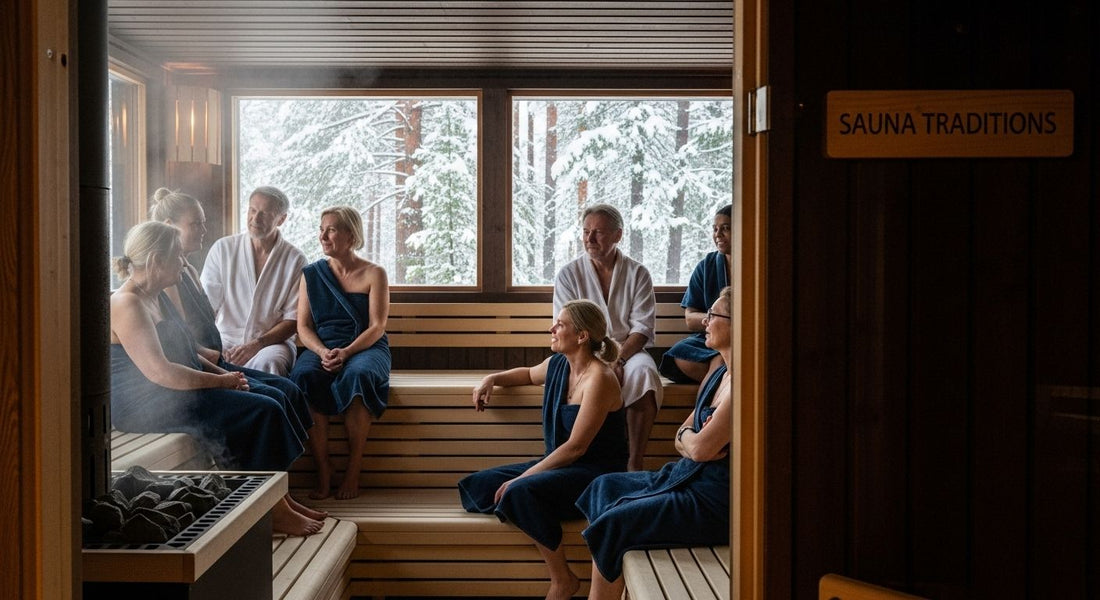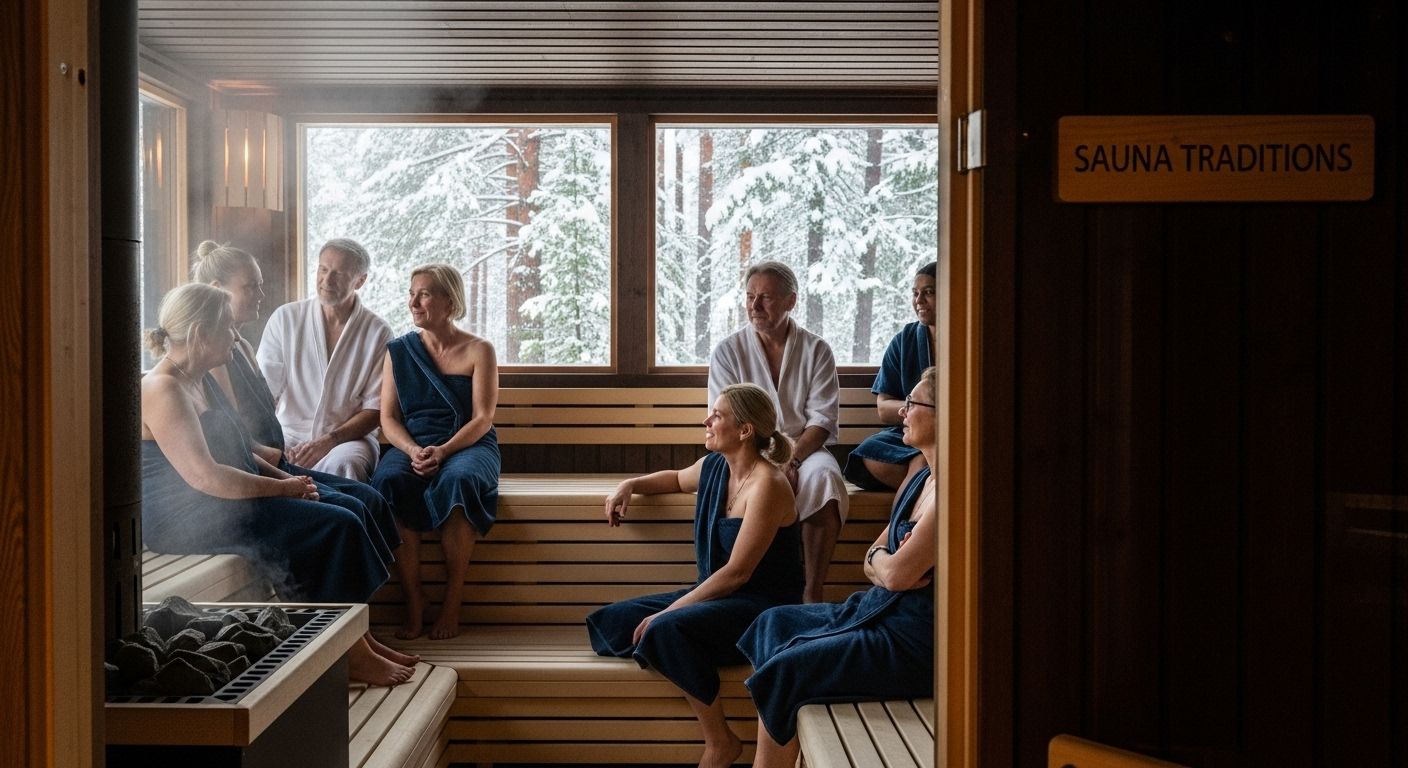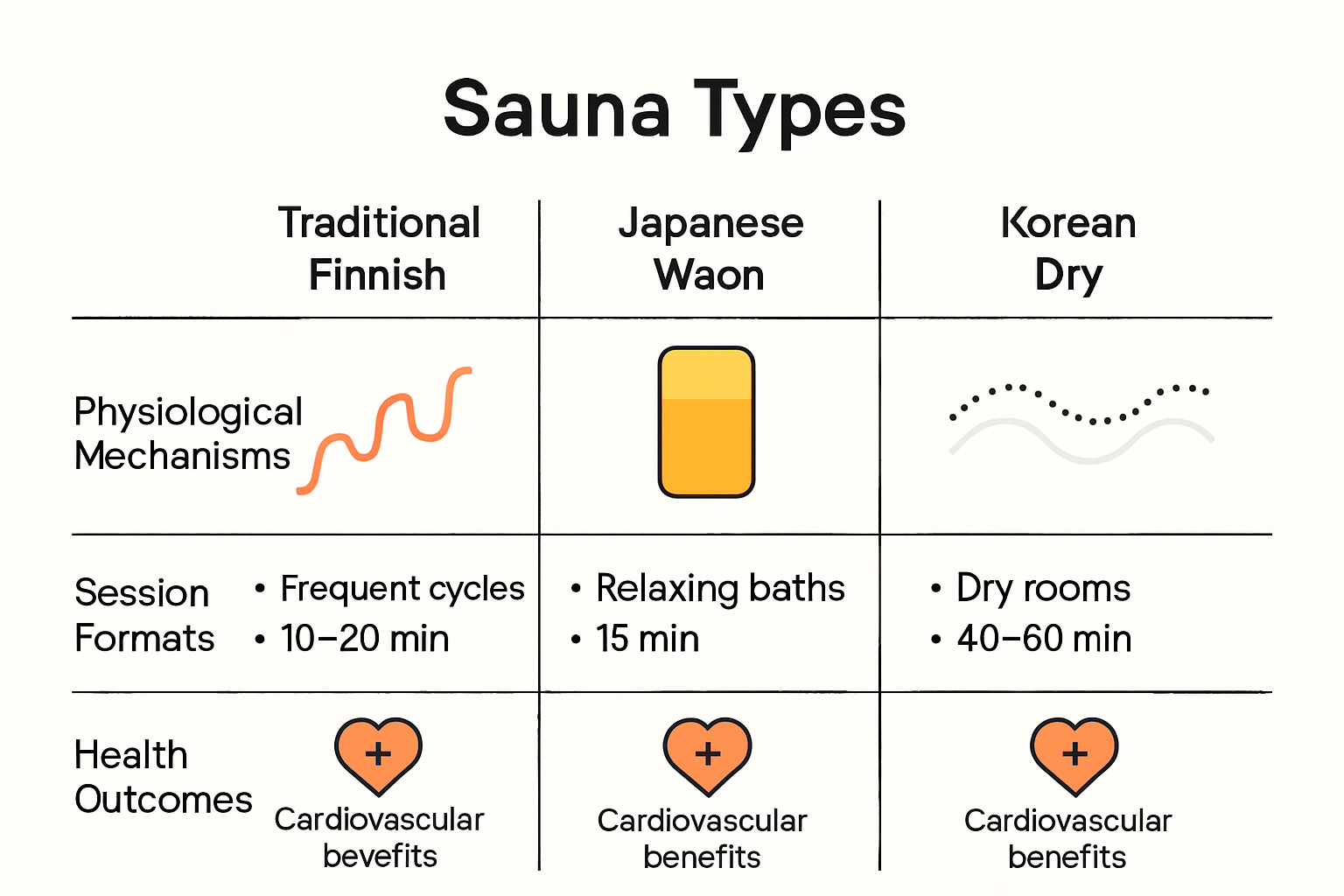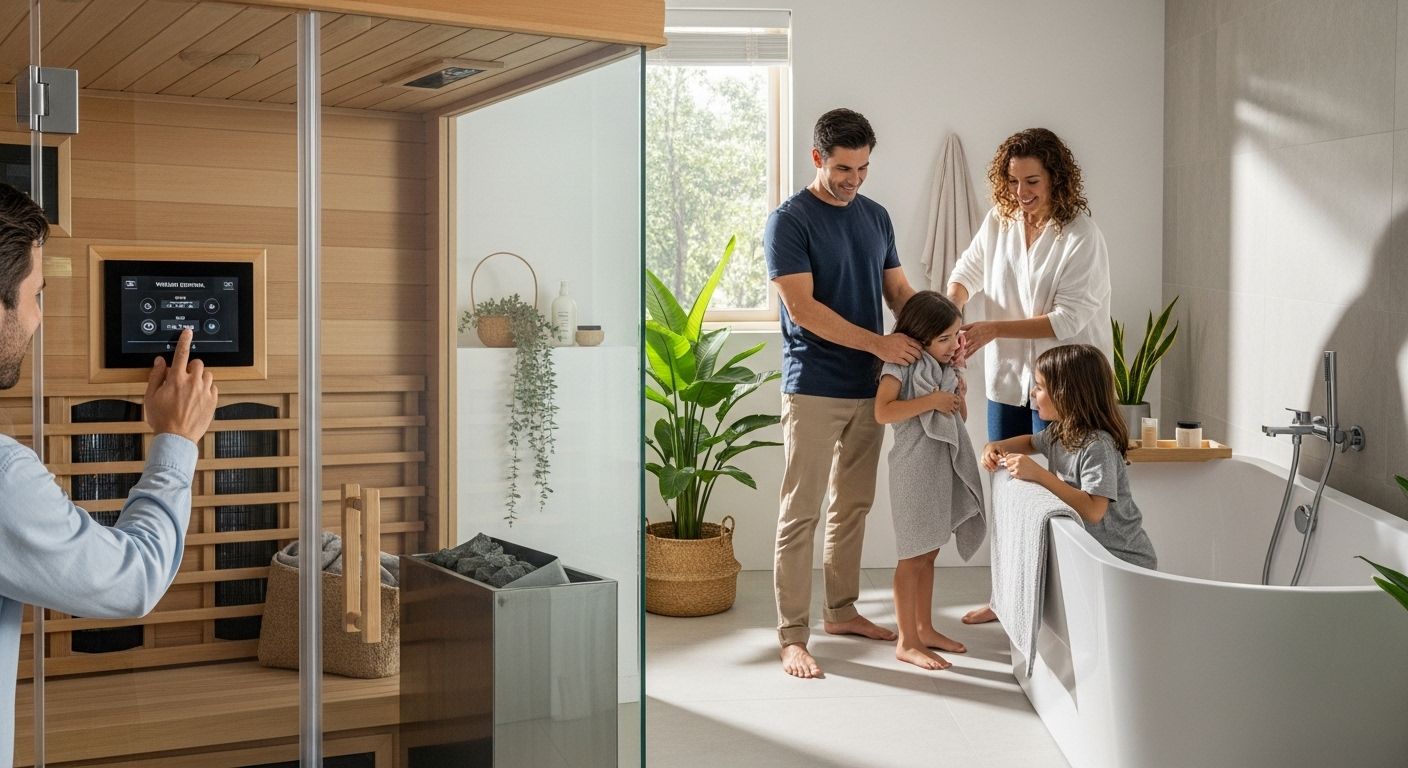
Sauna in Different Cultures: Global Traditions and Wellness 2025

Saunas are celebrated all over the world for their relaxing heat and social rituals. In Finland, nearly 99 percent of people enjoy the sauna at least once a week, making it a national obsession. Yet, the way cultures use saunas couldn’t be more different. Modern homes now feature smart, eco-friendly, and even wearable sauna technologies, reshaping what wellness looks like in 2025.
Table of Contents
- Finnish Sauna Traditions and Their Impact
- Japanese and Korean Sauna Culture Explained
- Innovative Sauna Practices in Modern Homes
- Choosing the Right Sauna for Your Wellness Needs
Quick Summary
| Takeaway | Explanation |
|---|---|
| Finnish saunas promote equality and social bonding. | In Finland, saunas serve as a communal space where social hierarchies dissolve, fostering deep connections among participants regardless of status. |
| East Asian saunas focus on diverse thermal experiences. | Japanese and Korean saunas offer varied styles and therapeutic benefits, incorporating cultural practices that enhance physical and mental wellness. |
| Modern saunas emphasize technology and personalization. | Contemporary sauna designs integrate smart technology and eco-friendly materials, allowing for tailored wellness experiences in homes. |
| Choosing a sauna requires understanding personal wellness goals. | Individuals should assess their health objectives, space availability, and preferred sauna type to select the most suitable option for their needs. |
| Saunas have proven physiological and psychological benefits. | Regular sauna use can improve cardiovascular health, enhance relaxation, and facilitate emotional release, contributing to overall well-being. |
Finnish Sauna Traditions and Their Impact
The sauna represents far more than a simple bathing ritual in Finnish culture. It is a profound social and spiritual experience deeply woven into the national identity, representing a sacred space of physical and mental purification. UNESCO’s recognition of Finnish sauna culture as Intangible Cultural Heritage in 2020 underscores its extraordinary significance beyond mere temperature and steam.
Historical and Cultural Significance
Traditionally, Finnish saunas were more than just wellness spaces. They served critical functional roles throughout Finnish history. Historically, saunas were the cleanest environments in homes, used for everything from childbirth to preparing bodies for burial. This multifunctional approach transformed the sauna from a simple heat room into a deeply ritualistic space that symbolized life’s most profound transitions.
The cultural importance extends beyond practical uses. Saunas represent a democratic space where social hierarchies dissolve. Whether a farmer or a government official, everyone sits equally naked, symbolizing fundamental human equality. This egalitarian aspect has been a cornerstone of Finnish social philosophy, where the sauna serves as a great equalizer.
Wellness and Physiological Benefits
Modern scientific research continues to validate the traditional wisdom surrounding Finnish sauna practices. A groundbreaking study in the Journal of Human Hypertension revealed fascinating physiological changes during sauna sessions. Researchers discovered acute increases in interleukin-6 and interleukin-1 receptor antagonist levels among middle-aged and older adults, suggesting potential anti-inflammatory mechanisms.
The thermal experience triggers remarkable bodily responses. Extreme heat causes blood vessels to dilate, improving circulation and potentially supporting cardiovascular health. Repeated sauna sessions have been associated with reduced risk of hypertension, improved metabolic function, and enhanced stress management. The combination of heat exposure and subsequent cooling creates a unique physiological reset that many Finnish people consider essential to their wellness routine.
Social and Psychological Dimensions
Research from the University of Vaasa highlights the sauna’s role as a ‘third space’ that transcends physical healing. It is a sanctuary for mental restoration, facilitating deep conversations, emotional release, and social bonding. Families, friends, and even business colleagues gather in this intimate environment, sharing experiences that strengthen interpersonal connections.
The psychological benefits are profound. The meditative quality of heat, combined with rhythmic löyly (throwing water on hot stones), creates a mindfulness experience. Participants often describe a sense of spiritual cleansing, where physical sweat symbolizes emotional and mental detoxification. This holistic approach transforms the sauna from a mere wellness practice into a ritualistic journey of personal renewal.
Finnish sauna culture exemplifies how a seemingly simple tradition can embody complex cultural, physiological, and psychological dimensions. It represents a harmonious intersection of individual well-being and collective experience, inviting us to reimagine wellness beyond conventional boundaries.

Japanese and Korean Sauna Culture Explained
East Asian sauna traditions represent a fascinating intersection of wellness, cultural practice, and social interaction. Unlike Finnish saunas, Japanese and Korean thermal bathing experiences offer unique approaches to physical and mental restoration that reflect deep-rooted societal values and historical practices.
Traditional Bath Structures and Origins
A comprehensive literature review on sauna traditions reveals the intricate diversity of East Asian thermal practices. Japanese bathing culture features multiple distinctive styles including mushi-buro (steam bath), kama-buro (hot room heated by a boiler), and ishi-buro (stone-carved hot room). Each variation represents a nuanced approach to heat therapy and relaxation.
Korean traditions similarly showcase remarkable depth. The hanjeungmak, a domed stone structure used for medicinal purposes since the 15th century, exemplifies a sophisticated understanding of thermal healing. These spaces were not merely recreational but served critical health and social functions, reflecting a holistic approach to wellness that integrates physical treatment with communal experience.
Here is a comparison table summarizing the main features and purposes of traditional Japanese and Korean sauna structures described above. This helps clarify the differences in design and cultural role.
| Sauna Type | Country | Structure/Design Characteristics | Main Purpose |
|---|---|---|---|
| Mushi-buro | Japan | Steam bath, moist heat | Relaxation, physical restoration |
| Kama-buro | Japan | Hot room heated by boiler | Heat therapy, relaxation |
| Ishi-buro | Japan | Stone-carved hot room | Heat therapy, traditional wellness |
| Hanjeungmak | Korea | Domed stone chamber, medicinal use | Medicinal health, social gathering |
| Jjimjilbang | Korea | Large public bathhouse, multiple sauna rooms | Communal wellness, social interaction |
Health and Wellness Implications
Research published in the Korean Journal of Family Medicine provides scientific insight into the therapeutic potential of these practices. A clinical study examining dry sauna therapy revealed significant health benefits. Participants underwent 15-minute sessions at 90.6°C twice daily for four consecutive days, demonstrating improvements in health-related quality of life among obese individuals without experiencing adverse events.
Interestingly, the methodology differs from Japanese Waon therapy, which typically involves 15-minute sessions at 60°C once daily over ten days. These variations highlight the nuanced approaches to thermal therapy across different cultural contexts, suggesting that heat exposure protocols can be tailored to specific health objectives.
Social Dynamics and Cultural Significance
A study exploring wellness tourism perspectives among Westerners in South Korea illuminates the broader social dimensions of these practices. Researchers surveyed 225 individuals who had experienced jjimjilbang (Korean public bathhouses), uncovering a fascinating correlation between sauna frequency and self-reported health evaluations.
These communal spaces transcend mere physical cleansing. They represent social equalizers where hierarchical distinctions dissolve, much like Finnish saunas. Participants engage in shared experiences, fostering connections that extend beyond individual wellness. The jjimjilbang becomes a microcosm of social interaction, where conversations flow as freely as the steam, and community bonds are strengthened through collective relaxation.
East Asian sauna cultures demonstrate that thermal experiences are far more than temperature and humidity. They are living traditions that encode complex narratives of health, social connection, and cultural identity. By understanding these practices, we gain profound insights into holistic approaches to human well-being that integrate physical, mental, and social dimensions.
Innovative Sauna Practices in Modern Homes
The contemporary home wellness landscape is transforming, with saunas evolving from traditional spaces to cutting-edge wellness technologies that blend design, functionality, and personalized health experiences. Homeowners are no longer viewing saunas as luxury additions but as integral components of holistic well-being strategies.
Technological Integration and Smart Design
Architectural innovations are redefining sauna experiences, moving beyond conventional wooden boxes to sophisticated wellness environments. Modern sauna designs now incorporate minimalist aesthetics with sustainable materials like thermally treated wood, glass, and stone. These spaces are not just functional but serve as architectural statements that seamlessly integrate with contemporary home designs.
Technology plays a pivotal role in this transformation. Touch-controlled interfaces, integrated LED lighting, and energy-efficient heating systems have revolutionized how we interact with thermal wellness spaces. Homeowners can now control temperature, humidity, and even chromotherapy lighting through smartphone applications, creating personalized healing environments at the touch of a button.
Sustainable and Eco-Friendly Innovations
Sauna design trends for 2025 emphasize environmental consciousness, with a strong focus on sustainable practices. Manufacturers are increasingly utilizing eco-friendly materials and energy-efficient technologies. Infrared saunas have gained significant popularity, offering targeted health benefits while consuming less energy compared to traditional steam saunas.
According to industry experts like Jennifer Thayer, sustainable wood choices such as thermally modified wood, bamboo, and reclaimed materials are becoming standard. These materials not only reduce environmental impact but also provide unique aesthetic qualities that enhance the overall wellness experience.
Personalized Wellness and Space Optimization
The modern home sauna is no longer a one-size-fits-all solution. Emerging trends showcase highly personalized approaches that cater to individual wellness needs. Outdoor saunas with panoramic windows are gaining traction, offering immersive nature experiences while providing health benefits. Some designs feature insulated, weatherproof structures that can be integrated into various architectural settings.
Technological advancements now include wearable sauna technologies that track physiological responses, allowing users to customize their thermal therapy experiences. Conductive carbon fiber panels ensure even heat distribution, while solar-powered options provide off-grid wellness solutions for environmentally conscious consumers.
Innovative sauna practices represent more than technological advancements. They symbolize a holistic approach to wellness that considers physical health, mental well-being, environmental sustainability, and personal aesthetic preferences. As homes become increasingly multifunctional spaces, saunas are emerging as dynamic wellness centers that adapt to individual lifestyles and health objectives.
Choosing the Right Sauna for Your Wellness Needs
Selecting the ideal sauna is a nuanced process that extends beyond simple aesthetic preferences. It involves understanding individual health goals, spatial constraints, technological options, and personal wellness objectives. The right sauna can transform your health routine, offering targeted benefits that align with specific physiological needs.
Health Considerations and Wellness Objectives
Research published in Mayo Clinic Proceedings reveals diverse health benefits associated with regular sauna use, including improved vascular health, enhanced respiratory function, and pain relief for musculoskeletal conditions. When choosing a sauna, individuals must first assess their primary wellness goals.
For those seeking cardiovascular improvements, traditional Finnish-style saunas with high-temperature sessions might be optimal. Individuals managing chronic pain or seeking muscular recovery might prefer infrared technologies that provide deeper tissue penetration. People with respiratory challenges could benefit from specific humidity levels and heat configurations that support lung function.
Technological and Design Considerations
Modern sauna technologies offer unprecedented customization. Infrared saunas utilize electromagnetic waves to generate heat directly within body tissues, providing more targeted therapeutic experiences. Traditional steam saunas offer comprehensive heat exposure, promoting overall sweating and detoxification. Hybrid models combine multiple heating technologies, allowing users to personalize their thermal experience.
Space requirements and installation complexity vary significantly. Portable infrared units offer flexibility for apartment dwellers, while custom-built wooden saunas require dedicated architectural planning. Factors like electrical requirements, ventilation, material durability, and maintenance complexity should guide decision-making. Some contemporary models integrate smart technologies, enabling remote temperature control and physiological tracking.
The following table summarizes the different sauna types discussed in the section above, highlighting their heating methods, benefits, and key considerations to help readers with the selection process.
| Sauna Type | Heating Method | Main Benefits | Key Considerations |
|---|---|---|---|
| Finnish (Traditional) | High-temp steam/wood stove | Cardiovascular health, deep sweating | Needs ventilation, dedicated space |
| Infrared | Electromagnetic infrared | Deep tissue relief, energy efficiency | Lower temps, portable options available |
| Steam (Hybrid/Traditional) | Steam | Detoxification, skin hydration | High humidity, moisture control needed |
| Hybrid | Both traditional & infrared | Customizable experience | Cost, installation complexity |
Practical Selection Strategies
Recent cultural insights from Minnesota’s sauna enthusiasts highlight the growing popularity of home wellness spaces, particularly in regions with extreme temperatures. The key is matching sauna characteristics with personal lifestyle and health parameters.
Consider these critical selection criteria: personal health history, available space, budget constraints, desired temperature range, energy efficiency, and maintenance requirements. Consultation with healthcare professionals can provide personalized recommendations, especially for individuals with pre-existing medical conditions.
Like UNESCO’s description of Finnish sauna culture emphasizes the holistic nature of thermal experiences, choosing a sauna transcends mere equipment selection. It represents a commitment to comprehensive wellness that integrates physical restoration, mental relaxation, and personal rejuvenation.
Ultimately, the perfect sauna is not a universal standard but a personalized wellness sanctuary tailored to individual needs, preferences, and health aspirations. By carefully evaluating technological options, health objectives, and practical constraints, individuals can transform their thermal experience from a simple heat session into a profound journey of holistic well-being.

Frequently Asked Questions
What are the health benefits of using a sauna?
Regular sauna use can improve cardiovascular health, enhance relaxation, aid in stress management, and provide benefits for skin health through improved hydration and detoxification.
How does sauna culture vary between Finland and East Asia?
In Finland, saunas are communal spaces that promote social equality and personal well-being, while in East Asia, such as Japan and Korea, sauna practices incorporate diverse thermal experiences that emphasize social interaction and holistic health.
What modern technologies are incorporated into home saunas?
Modern home saunas are equipped with smart technology, including touch controls, integrated lighting, and energy-efficient heating systems, allowing users to personalize their sauna experience easily.
How do I choose the right sauna for my wellness needs?
To choose the right sauna, assess your personal health goals, available space, budget, and preferences for heating method (traditional or infrared) to find the best option that meets your wellness objectives.
Bring Global Wellness Home With Best Life Sauna
Are you inspired by the powerful healing and connection found in Finnish, Japanese, and Korean sauna traditions, but unsure how to create your own personalized sanctuary? The article highlights how diverse cultures use saunas to promote equality, foster deeper bonds, and deliver real health benefits like improved circulation and stress relief. Yet bringing this experience into your daily routine can feel overwhelming, especially when navigating options or seeking trusted products that suit your unique wellness goals.

At Best Life Sauna, we make home wellness accessible and tailored to you. Explore our range of infrared and traditional saunas, outdoor models, and premium accessories designed for all lifestyles and spaces. Enjoy total peace of mind with our price match guarantee, free shipping on orders over $200, and outstanding customer support. Ready to transform your wellness routine? Visit Best Life Sauna now to find the perfect sauna for your needs and take the first step in making everyday rituals truly meaningful.

